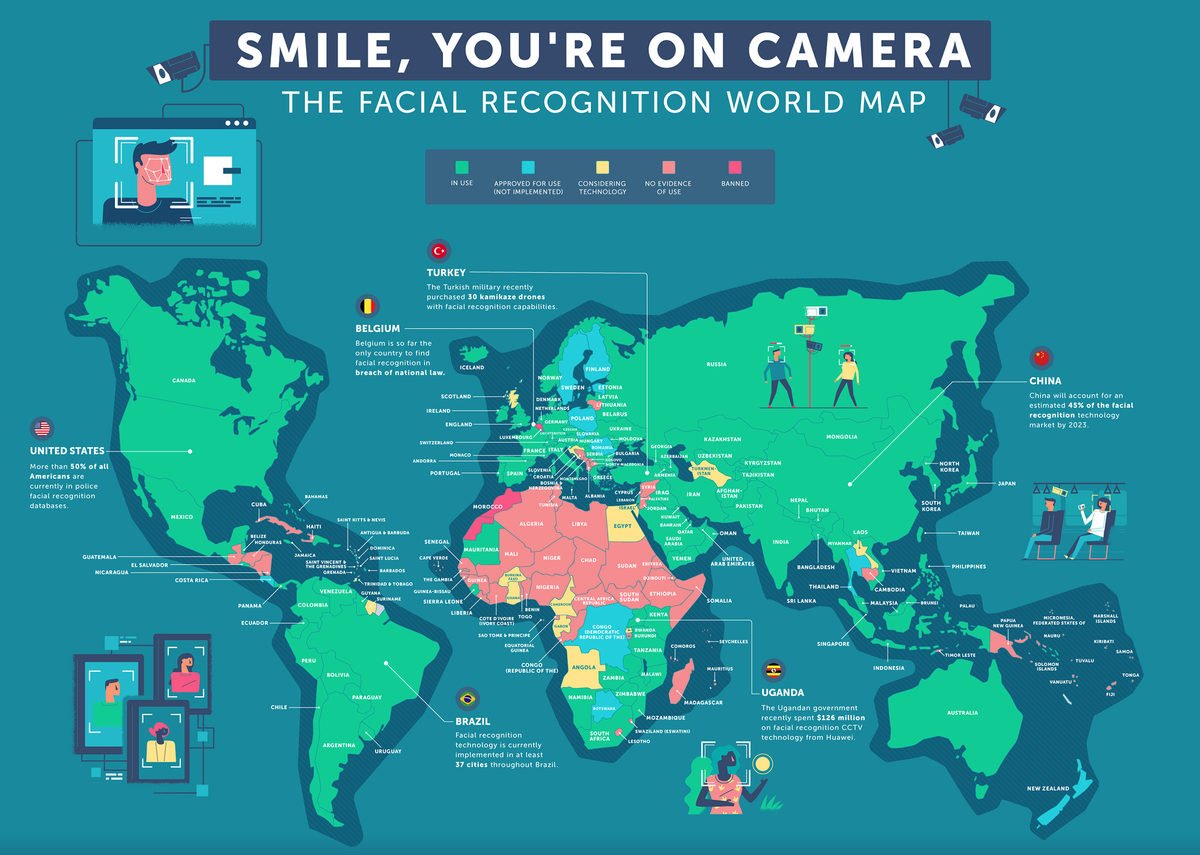Over the past 10 years, the very use of facial recognition technology in surveillance has become more and more common around the world and the computer programs that analyze images of human faces to identify them are used to pick out criminals and sometimes can even find lost children in seconds.
There is a good chance that at some point you’ve been watched, scanned or even analyzed by facial recognition technology, even without realizing it. There are now 109 countries, that are either using or have approved the use of facial recognition technology for surveillance purposes. The spread of this technology around the world has raised millions of important questions about the impacts on the privacy of such widespread surveillance.

The use and widespread of facial recognition technology around the world and distilled that into a series of maps:
- The countries where facial recognition technology is already in use.
- The countries that have approved its use and not implemented yet.
- The countries considering the technology.
- The countries that have banned it.
Facial Recognition Map of Europe:
- Moscow used facial recognition technology to monitor whether potential carriers of coronavirus were obeying rules of their quarantines.
- Belgium is the only country so far to find facial recognition in breach of national law.
- A study discovered Facial recognition technology use by London Police was inaccurate in 96% of cases.
- The first arrest to result from facial recognition surveillance took place on February 27, 2020.
- France and Sweden recently banned the use of facial recognition in schools.
- German police currently use technology and have plans to install facial recognition cameras in 134 train stations and 14 airports.
- In the Czech Republic, facial recognition cameras have led to at least 160 arrests at Prague Airport since mid-2018.
- Police facial recognition cameras in France match a subject’s image against a database of 8 million photos.
- Facial recognition cameras in the Netherlands compare subjects against a police database of 2.2 million images representing 1.3 million people.
- Belgium and Luxembourg are two of only three governments in the world to officially oppose the use of facial recognition technology.
Facial Recognition Map of North America:
- 26% of Americans believe that the government should restrict the use of facial recognition technology.
- In the year 2019, San Francisco became the first U.S city to ban the police use of facial recognition technology.
- More than 50% of all Americans are currently in police facial recognition databases.
- The Bahamas recently used facial recognition technology to search for missing persons in the wake of Hurrican Dorian.
- In Dominican Republic’s Punta Cana Internation Airport, the facial recognition allows users to pass through security in just 10 seconds.
Facial Recognition Map of South America:
- The technology helped Argentinian police make 590 positive identifications in just six weeks in 2019.
- Facial recognition feeds from just 16 cameras were used to make 134 arrests during Brazil’s Carnival festival in 2019.
- Brazil’s facial recognition system alerts authorities when there is a match in physical similarities of 90% or greater.
- Facial recognition technology is currently implemented in at least 37 cities throughout Brazil.
Facial Recognition Map of the Middle East & Central Asia:
- Qatar is currently planning to implement a wide-ranging facial recognition identification system for the 2022 FIFA World Cup.
- UAE police recently purchased 50 ‘smart glasses’ that allow users to identify faces in a crowd using facial recognition technology.
- Israel has a system of 27 cross-points in the West Bank where facial recognition technology is used to track Palestinians.
- Kazakhstan is currently implementing the technology to use facial recognition in lieu of tickets on public transport.

Facial Recognition Map of Asia & Oceania:
- 2017, China filed more than 900 facial recognition patents, versus 96 filled in the United States.
- Australia has proposed facial recognition to verify the ages of people seeking to watch shady websites.
- China has 170 million surveillance cameras installed throughout the country, approximately one for every 12 people.
- 18 countries worldwide had purchased and installed Chinese facial recognition technology.
- Japan plans to implement facial recognition technology at casinos as part of an effort to curb gambling addiction.
- Stores use facial recognition cameras in Japan experienced a 40% decrease in shoplifting incidents compared to stores without the technology.
- Singapore plans on installing cameras on all 111,000 lamp posts throughout the country.
To create these maps, there is a use of the legal status of facial recognition in 194 countries and territories using a variety of sources.
“The goal of the map is to educate people about where facial recognition technology is being used across the country and the different ways that it’s happening and then give them the tool to do something about it.” – Evan Greer
Proponents of facial recognition that typically identifies people from video or photos by comparing their facial features with those in the database and can help solve crimes. Whether you approach facial recognition technology from the public and national security lens or from an individual liberty perspective, it’s clear that this kind of surveillance is here to stay.



